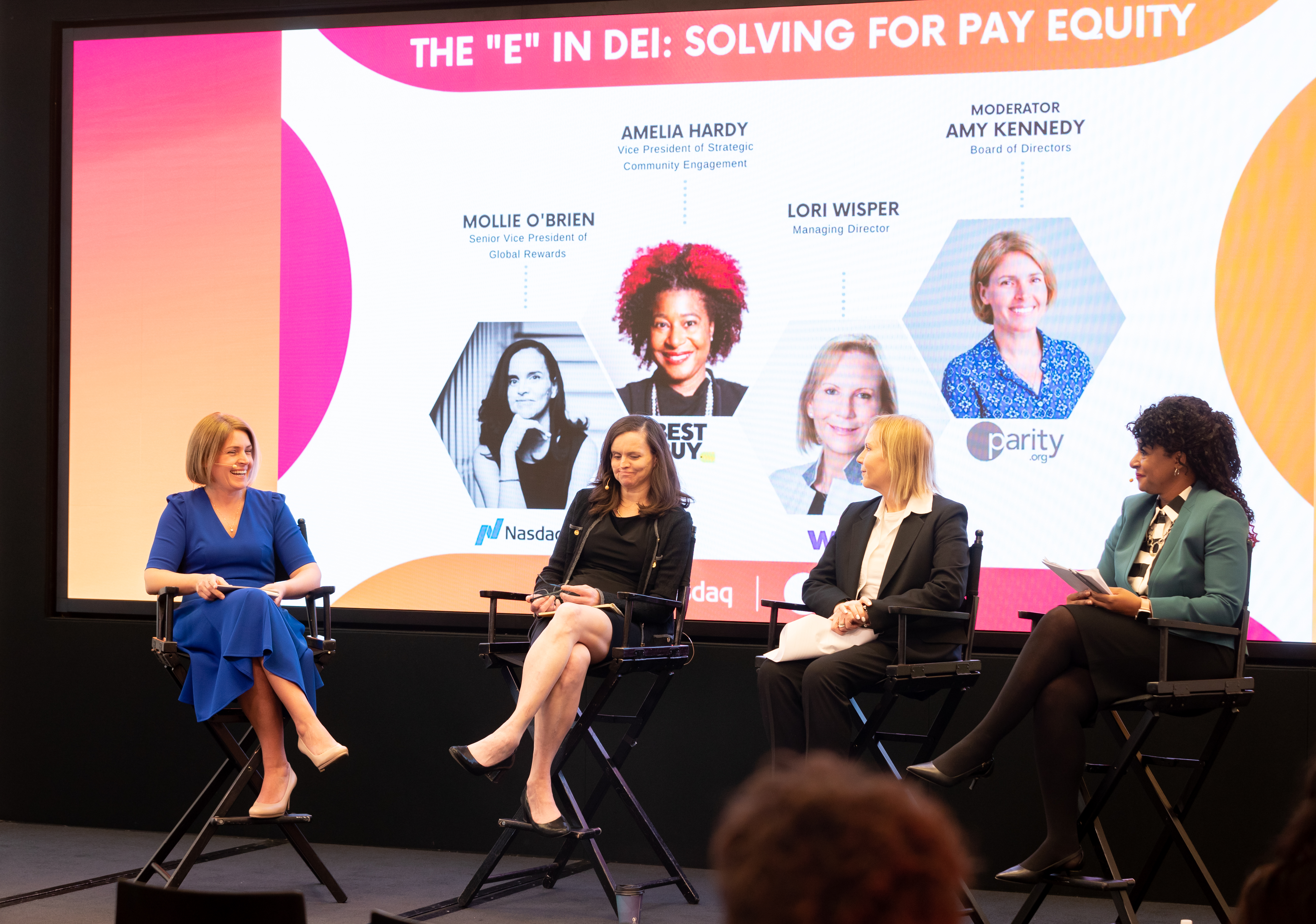
Achieving Pay Equity Is About More than Pay
In Celebration of Women’s History Month, Nasdaq and Parity.org hosted a panel of women leaders to discuss the “E” in Diversity, Equity and Inclusion (DE&I), with female executives from BestBuy, Willis Towers Watson (WTW) and Nasdaq. During their conversation about the continued problem of pay equity for women, the panel largely agreed that to achieve pay equity, propel women into management positions and retain them at the top, the infrastructure of work needs to change.

Amy Kennedy, board director at Parity.org, a company dedicated to closing the gender and racial gap at the highest level of business, painted a grim picture of the pay gap without immediate intervention.
“At our current pace, it is expected that we won’t close the wage gap until the year 2157…that’s nearly 136 years from now,” said Kennedy, who noted that 36 years were added to make up for pandemic setbacks.
Pay equity remains a problem despite the recent push for environmental, social and governance (ESG) and DE&I initiatives from companies that want to do better, according to Lori Wisper, Managing Director of WTW.
“I’ve had clients that do [pay] remediation repeatedly. They do their pay equity analytics every couple of years, and they will say to me, ‘why is [the pay equity gap] back? I thought we “fixed” that when we spent all that money last time.’” Wisper said.
Pay inequities return, according to Wisper, because companies are dynamic: they acquire other companies, hire new people and reorganize. This often revives the foundational pay inequity practices that helped cause the gap in the first place.
“The root causes are not necessarily about pay, but about representation at different levels…it is about asking: Who do we hire? How do we source? How do we develop people? Who do we promote? Those things don’t cost money; they are about solid HR foundational practices,” said Wisper.
Furthermore, the panel widely agreed that the problem of pay inequity continues because companies haven’t changed the infrastructure to ensure pay equity at all levels.
Mollie O’Brien, Senior Vice President of Global Rewards at Nasdaq, echoed the need for foundational human resource changes, including eliminating discretionary bonuses and changing the “gift” mindset behind promotions and salary bumps.
“Promotions feel like a gift. It is so fundamentally different than negotiating a new job where you have leverage…95% of the time people don’t come back and say, ‘this [salary increase] wasn’t enough for me.’ Because what do you do with a gift? You receive it,” said O’Brien.
She stressed the need for behind-the-scenes systems that ensure equitable promotions and pay for women and underrepresented groups.
“You need to ensure that there is equity in each building block of compensation,” O’Brien said.
Amelia Hardy, Vice President of Strategic Human Engagement at Best Buy, espoused career equity as the bucket term for non-biased and equitable workplace initiatives that can uplift women and underrepresented groups toward career advancement.
Hardy said Best Buy strives to create career equity for all her employees, including seasonal and temporary workers.
When asked about the intersectional experiences of pay inequity, Hardy pointed to the biases that create a hierarchy of privilege. To eliminate these biases, Best Buy utilizes education through unconscious biases training and inclusivity training for their management teams. Hardy believes that these initiatives can help reform the workplace to be a more diverse and inclusive space that will eventually improve pay equity.
“As we diversify the rooms…as we take away biases through training and as we bring more people into leadership roles that bring in people who look like them, I think we will start to chip away at that bias that impacts pay equity and career equity for people of color,” said Hardy.
The panel largely agreed that flexible work schedules are a boon to women in all industries, who statistically still take on the brunt of household responsibilities and caregiving. Flexibility at work allows women to do both with quality.
Hardy called for a change from work/life balance to work/life integration: ebbing and flowing one’s schedule and priorities to meet the needs of both work and life in a healthy and productive way. She was encouraged to see leaders in multiple industries embracing and engaging in hybrid and flexible work models that support women and all employees in different stages of their career and life.
O’Brien highlighted Nasdaq’s permanent flex day program as a means of increasing flexibility in the workplace. During the pandemic, Nasdaq launched this program for all employees, giving two paid days off a month with no questions asked. O’Brien found that while it certainly helped women with new caregiving responsibilities, it also helped employees across the board with things like mental health.
“When we gave flexibility, I had these employee groups…and some people were thinking about their flex days as mental health days,” said O’Brien. “That’s why we need to expand the programs to not just be about parents.”
With the panel in agreement on changes in work infrastructure, policy and education to solve pay equity, O’Brien summed up the discussion in her closing remarks.
“If our North Star is that we want equitable opportunities and careers for women, you need to have great caregiving options…you need to have that flexibility, and you need to have managers with a mentality that says, ‘It’s okay to be ambitious here and love the people that you love at home,’” O’Brien concluded.
